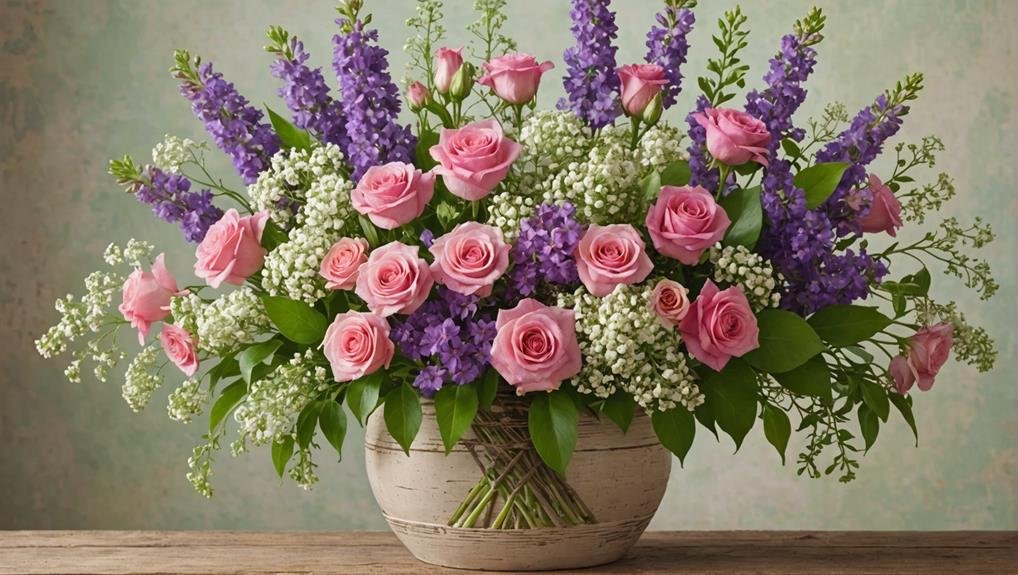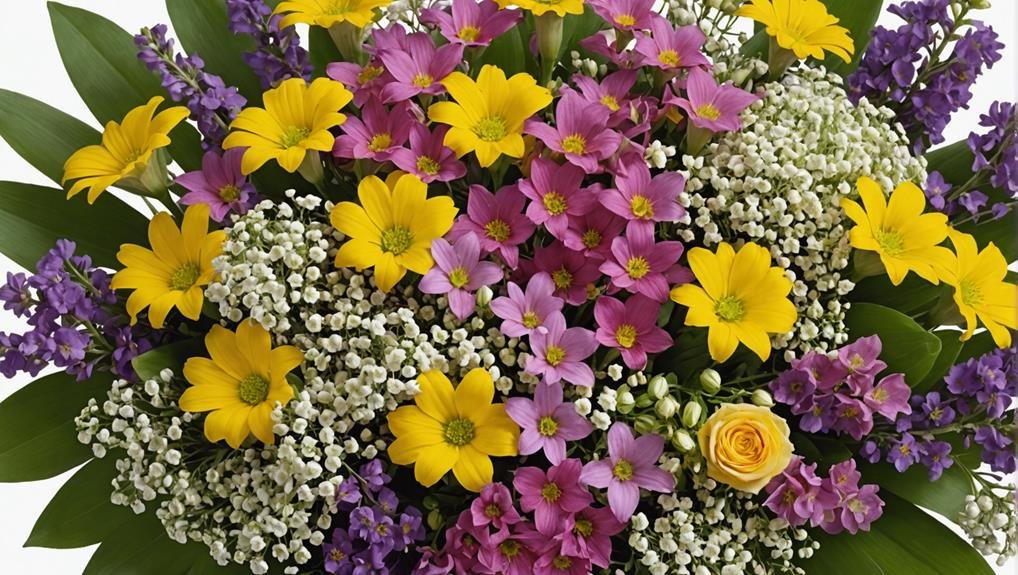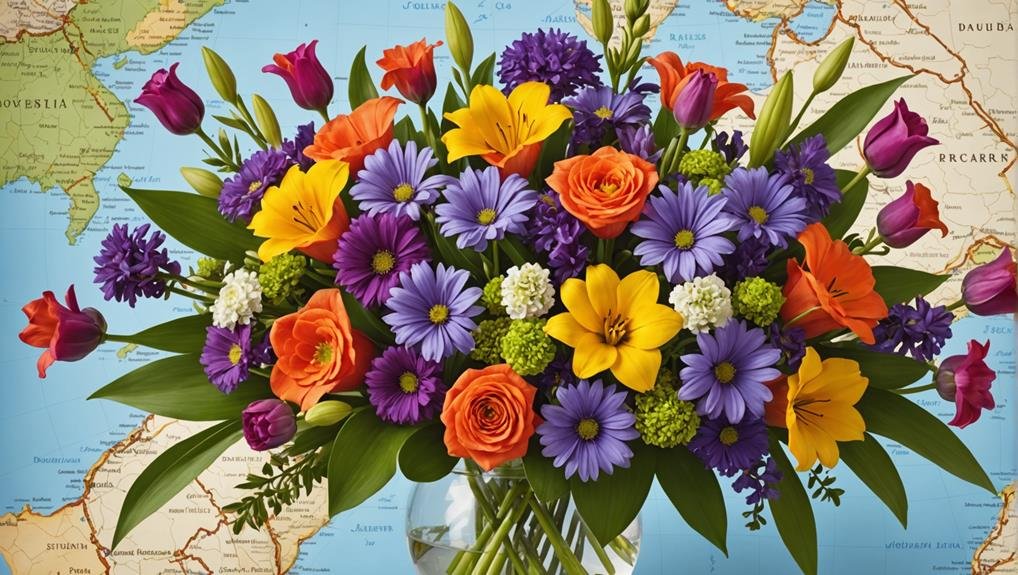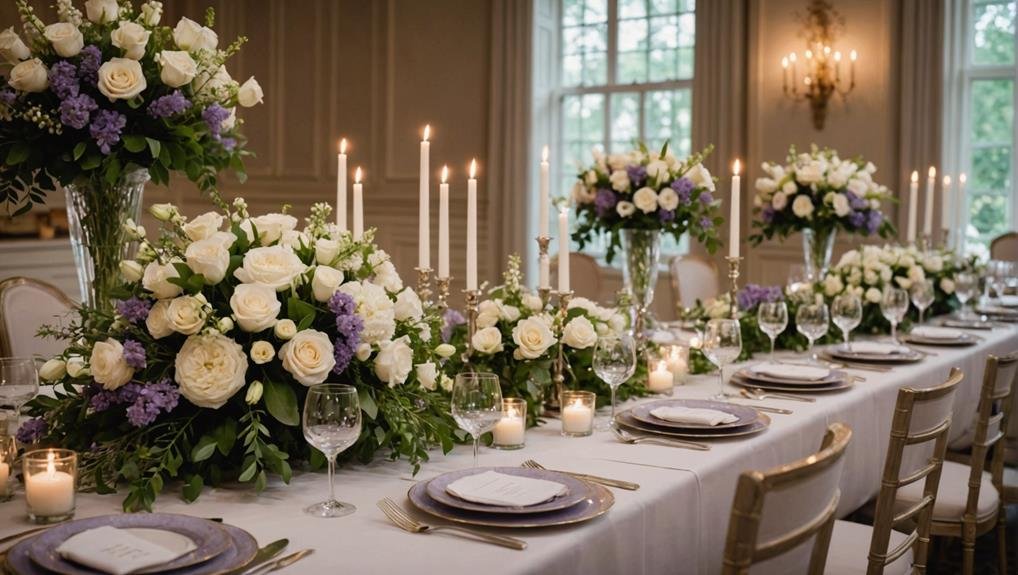When planning a wedding, selecting the perfect flowers is pivotal, and stock flowers offer an elegant choice with their sweet fragrance and delicate appearance. Known in botanical circles as Matthiola incana, stock flowers boast a rich history and are celebrated for their range of colors, which include white, peach, lavender, and yellow. These blooms are not just visually pleasing; they hold significant symbolic meanings such as purity, warmth, and romance. The versatility and charm of stock flowers make them an excellent addition to wedding bouquets and arrangements. But what makes these flowers truly stand out in wedding decorations?
Flower Overview

Stock flowers, also known as gillyflowers and Virginia stock, are renowned for their sweet fragrance and popularity in wedding bouquets. These blossoms, named after the 16th-century Italian botanist Pietro Andrea Matthioli, are a favorite in the world of wedding flowers. Their versatility and charming scent make them ideal for various floral arrangements. In the context of weddings, stock flowers are often used to add a touch of elegance and a delightful aroma to bouquets and centerpieces.
When it comes to floral arrangements, stock flowers are typically sold in wraps of ten stems, with stem lengths reaching up to 60 centimeters. Florists and event planners often purchase these flowers direct from wholesalers, making sure they receive the freshest blooms for their creations.
Proper conditioning is essential for maintaining the quality of stock flowers. This involves filling buckets with lukewarm water, adding flower food, and allowing the flowers to condition overnight in a cool, sun-free environment.
The careful preparation and conditioning of stock flowers ensure that they are in peak condition for wedding use. Their enchanting fragrance and classic beauty make them a staple choice for brides and florists alike, enhancing the ambiance of any wedding celebration.
Physical Description
Matthiola flowers display dense clusters of delicate, fragrant blooms atop sturdy, upright stems, making them a visually striking addition to any floral arrangement. These flowers are known for their sweet aroma and are often sold in bundles of 10 stems, with lengths reaching up to 60cm. Their compact, multi-flowered spikes create an abundant and lush appearance, perfect for enhancing the elegance of wedding bouquets and centerpieces.
To guarantee the longevity of these cut flowers, proper preparation is essential. Begin by trimming the stems at a 45-degree angle and removing any lower foliage that might dip below the waterline. Conditioning the flowers overnight in lukewarm water with flower food will help them remain fresh and vibrant. It is vital to store Matthiola in a cool place, away from direct sunlight and the harmful gases emitted by ripening fruit.
| Feature | Details | Importance |
|---|---|---|
| Sweet Aroma | Intense, pleasing fragrance | Enhances ambiance |
| Stem Length | Up to 60cm | Versatile for arrangements |
| Conditioning | Lukewarm water, flower food | Ensures longevity |
White stock, in particular, is highly valued for its purity and timeless look, seamlessly fitting into various wedding themes. Proper care and handling of these flowers will guarantee they maintain their beauty and fragrance throughout the special day.
Available Colour Varieties

Available in a diverse palette, stock flowers offer a range of colors including white, peach, lavender, yellow, and purple, each adding a unique touch to wedding floral arrangements. This range of colors allows for versatile and colorful floral arrangements, catering to various wedding themes and palettes. Each color variety carries its own symbolism, enhancing the depth and meaning behind the floral choices.
- White Stock Flowers: Symbolizing purity, white stock flowers are often used to convey innocence and elegance. They seamlessly blend into most wedding themes, offering a classic and timeless feel.
- Peach Stock Flowers: Representing appreciation, peach stock flowers add a warm and inviting hue to bouquets and centerpieces, creating a welcoming ambiance.
- Lavender Stock Flowers: Signifying grace and elegance, lavender stock flowers bring a soft, romantic touch to any floral arrangement, perfect for vintage or rustic-themed weddings.
The availability of these diverse color varieties allows for creative combinations in bouquets, centerpieces, and other wedding floral arrangements. Brides can mix and match these colors to achieve the desired aesthetic, whether it's a vibrant, bold look or a soft, understated elegance. The versatility of stock flowers makes them a beloved choice for DIY brides seeking to add both sweet scent and visual appeal to their wedding decor.
Latin Name and Taxonomy
The botanical classification of stock flowers places them within the Matthiola genus, specifically known as Matthiola incana. This genus is a member of the Brassicaceae family, a diverse group that also includes well-known plants such as cabbages, mustards, and broccoli. The taxonomy of Matthiola incana aligns it with other flowering plants in the Brassicales order and the Plantae kingdom.
The latin name 'Matthiola' honors Pietro Andrea Matthioli, a distinguished 16th-century Italian botanist and physician renowned for his work in herbal medicine and plant taxonomy. His contributions to botany were significant enough to have this genus named after him, reflecting the lasting impact of his scientific endeavors.
Matthiola incana shares its family, Brassicaceae, with a variety of both ornamental and edible plants, uniting them under a common taxonomic umbrella. This family is characterized by its economic and ecological importance, as well as its botanical diversity. Stock flowers, with their rich history and intricate classification, thereby occupy a notable position within this family, contributing to both horticulture and ornamental floristry.
This foundational understanding of their taxonomy is essential for appreciating their role and significance in wedding floral arrangements.
Geographical Origins

Originating from the Mediterranean region, stock flowers have a rich history rooted in the warm climates and diverse landscapes of Southern Europe and North Africa. These sweetly scented blooms are revered not only for their beauty but also for their historical and botanical significance. Named after Pietro Andrea Matthioli, a distinguished Italian physician and botanist, stock flowers have long been admired for their vibrant colors and delightful aroma.
The Mediterranean region provides the ideal environment for stock flowers to thrive, with its temperate climate and fertile soil. This region's unique conditions have contributed to the robust growth and resilience of these flowers, making them a popular choice for florists and gardeners alike. Stock flowers are a staple in creating stunning bouquets due to their appealing fragrance and aesthetic versatility.
Floral enthusiasts often appreciate stock flowers for several reasons:
- Sweetly Scented: Their fragrance adds a delightful, aromatic touch to any floral arrangement.
- Versatile Bouquets: Stock flowers blend seamlessly with other blooms, enhancing the overall beauty of bouquets.
- Convenient Packaging: Typically sold in wraps of 10 stems, they are easy to handle and arrange.
The enduring allure and practical benefits of stock flowers make them a cherished addition to any floral ensemble.
Season Availability
Despite their Mediterranean origins, stock flowers boast year-round availability, guaranteeing they can grace weddings and events in any season. This consistent season availability makes them an attractive option for couples planning DIY weddings, as they can rely on these blooms regardless of when their special day takes place.
Stock flowers are not only versatile in their seasonal accessibility but also in their aesthetic contributions. Available in a variety of colors, they add a touch of elegance to bouquets and centerpieces.
However, to maintain their freshness, it is essential to follow proper care techniques. Stock flowers are particularly sensitive to extreme weather conditions and direct sunlight, which can compromise their delicate beauty. To counteract this, overnight hydration is recommended. By placing the stems in water and adding flower food, you can revitalize their appearance and guarantee they remain vibrant throughout the event.
Growing Conditions

Stock flowers flourish most in well-drained soil with ample sun exposure, especially favoring cooler temperatures for ideal growth. These conditions are vital for guaranteeing the robustness and vibrancy of the blooms. Stock plants require a full sun exposure to flourish, meaning they should receive at least six hours of direct sunlight daily. It's essential to plant them in a cool place, as they perform best in cooler climates.
Regular watering is another key aspect of growing stock flowers. The soil should be kept consistently moist but not waterlogged, as excessive water can lead to root rot. Hence, it's important to strike a balance, making sure that the soil is neither too dry nor too saturated.
To support the best growth of stock flowers, consider the following guidelines:
- Sunlight: Ensure the plants receive direct sunlight for at least six hours daily for full sun exposure.
- Watering: Implement a regular watering schedule, keeping the soil moist but avoiding waterlogging.
- Planting Location: Choose a cool place that can provide both the necessary sunlight and temperature conditions.
Cultural Significance
Beyond their specific growing needs, stock flowers have deep cultural significance, symbolizing a happy life, purity, and lasting beauty in various traditions. Originating from the Mediterranean region, these flowers are often associated with positive emotions and meanings in traditional folklore and customs. The vibrant colors of stock flowers, including white, peach, lavender, yellow, and purple, enhance their cultural significance in a wide range of ceremonies and rituals.
In many cultures, stock flowers are used to convey messages of joy, love, and well-being during significant life events. Their symbolism extends to embodying happiness, prosperity, and good fortune, making them a popular choice for celebrations.
The white stock flower, for example, is often seen as a symbol of purity, making it a fitting element in various rituals that emphasize innocence and unblemished beauty. Lavender and peach stock flowers, on the other hand, are often associated with a contented and happy life, reflecting the vibrant and enduring qualities that they symbolize.
Through their historical use in ceremonies and rituals, stock flowers have cemented their place as meaningful and versatile symbols in various cultural contexts.
Typical Use in Weddings

In wedding floral arrangements, stock flowers are prized for their sweet scent, fluffy blooms, and versatile colors, making them a favorite among brides and florists alike. These attributes, combined with their year-round availability, make stock flowers an ideal choice for various wedding applications.
Stock flowers are particularly loved by DIY brides due to their fresh look and bright green stems. Their ability to serve as both filler flowers and stand-alone blooms allows for a wide range of creative options in bouquets and arrangements. Here are three typical uses for stock flowers in weddings:
- Bouquets: Stock flowers add volume and texture to bridal bouquets. Their versatile colors, such as white, peach, lavender, yellow, and purple, can complement any wedding color scheme, adding a touch of elegance and purity.
- Centerpieces: Stock flowers make beautiful centerpieces, either on their own or paired with other flowers like roses and baby's breath. Their fluffy blooms create a lush, full look that enhances table settings.
- Decorative Arrangements: From altar decorations to aisle markers, stock flowers are a versatile choice. Their lasting beauty symbolizes a happy life and contented existence, perfectly aligning with the sentiments of a wedding celebration.
Incorporating stock flowers into wedding arrangements guarantees both aesthetic beauty and meaningful symbolism.
Alternative Flower Types
When stock flowers are not available, exploring alternative flower types such as snapdragons, larkspur, and delphiniums can provide equally stunning options for wedding arrangements. These flowers offer vibrant colors and unique shapes that can enhance the aesthetic of any bouquet or centerpiece.
If you're looking for flowers that can be substituted for stock flowers, consider lisianthus, ranunculus, or peonies. These blooms bring a similar elegance and can seamlessly fit into various designs.
For those seeking additional fullness and color in their arrangements, dahlias, hydrangeas, or asters are excellent choices. They provide the same lush appearance that stock flowers are known for.
To add texture and dimension, incorporating filler flowers like baby's breath, wax flowers, or statice can create a unique alternative to traditional stock blooms.
Greenery is another essential element in floral design. Including eucalyptus, ferns, or ivy not only complements the alternative flower types but also adds a fresh, natural touch to the arrangements.
